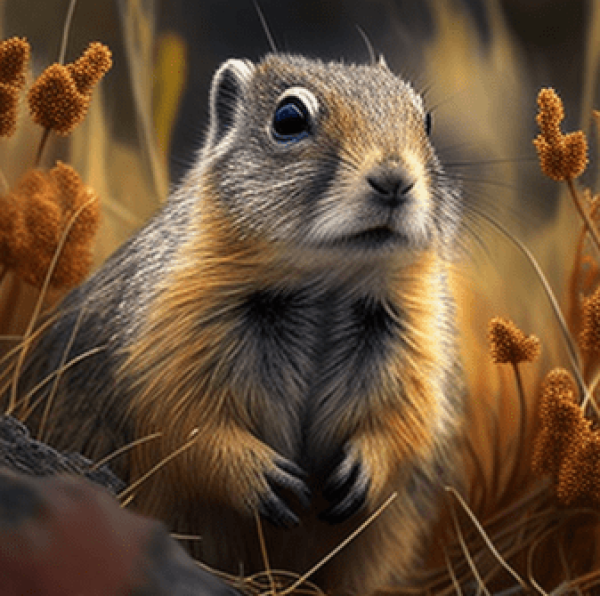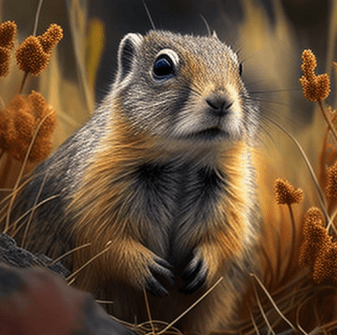Mormon Crickets
Table of Contents Mormon crickets, despite their name, are not true crickets, but a type of large insect that belongs

Ground squirrels, with their charming antics and fluffy tails, are common sights in many parts of the world. However, their presence can sometimes become a nuisance, especially when they invade your garden or burrow under your property.
In this article, we delve into the world of ground squirrels, exploring the key differences between these fluffy animals and their close cousins, chipmunks. In addition, you will learn fascinating facts about specific squirrel species, including the resilient Arctic ground squirrel and the notorious California ground squirrel. And for those seeking effective solutions, we provide expert advice on how to get rid of these pests and regain control of your space.
Ground squirrels and chipmunks differ in size, appearance, and behavior. Squirrels are larger and have a sturdy build, while chipmunks are smaller and more slender.
Ground squirrels are enthusiastic burrowers and live in colonies with well-established hierarchies. Chipmunks are mostly solitary or live in small families.
Both ground squirrels and chipmunks are mostly herbivorous, but chipmunks can also consume insects, small invertebrates, and bird eggs.
There are various species of squirrels encountered in the USA, including the Californian, Eastern, Uinta, Columbian, Arctic, Belding’s, and others.
The Arctic ground squirrel is well-adapted to living in Arctic and subarctic areas, with a long hibernation period and the ability to dig extensive burrow systems.
The California ground squirrel is a masterful digger and lives in grasslands, meadows, and open woodlands in the western United States.
To deter ground squirrels naturally, you can modify their habitat, use deterrent plants, predator urine, physical barriers, vibrations and noise, and encourage the presence of natural predators.
If natural methods fail, trapping and other removal methods can be considered, including live traps, kill traps (in compliance with local laws), fumigation, exclusion fencing, and professional services.
Both ground squirrels and chipmunks are small rodents, but they differ in size, appearance, and behavior. Squirrels are larger. They are around 8-12 inches (20-30 cm) long without a tail. Chipmunks are, accordingly, smaller – they are 5-6 inches (13-15 cm) in length.
Squirrels have a sturdy build, a thick bushy tail, and short legs. Their bodies are robust and stocky. Chipmunks are slender. Their bodies are more elongated, and their tails are bushy, too. However, when we look at ground squirrels vs. chipmunks, squirrels’ tails are shorter. They are meant to provide them with balance and stability. Chipmunks’ tails are longer and bushier. They are held upright and mostly used for communication.
The colors of squirrels are uniform, with dominating brown or gray. Some species may also display stripes or spots. Chipmunks have clear markings, like dark stripes along their backs. They may also have lighter stripes or patches on the sides and back.
Squirrels’ faces are round, and their ears are small and round, too. Their eyes are large and located on the sides of the head. Chipmunks’ faces are more elongated, with prominent large eyes. The ears are also larger.

In general, there are several species of both ground squirrels and chipmunks, and their appearance may vary. When we contrast the behavior and habitat preferences of ground squirrels vs. chipmunks, we will see different characteristics.
Squirrels are enthusiastic burrowers. Their burrow systems are complex, meant to protect them against predators and weather conditions. You can find squirrel nest places there, too. Their burrows also have multiple chambers and entrances. Chipmunks are mostly good climbers, and they spend the most time in trees. Their nests are also in tree stumps and cavities, though they can also dig underground burrows.
Squirrels are social animals, living in colonies with well-established hierarchies. They are very cooperative in their colonies. For example, they have alarm calls to warn others about potential dangers. Chipmunks do not live in colonies. They are usually solitary or live in small families. They establish boundaries of their family group with scent signals.
Squirrels are diurnal animals, meaning that they are active during the day. They forage for food and maintain their burrows at this time. Chipmunks are also diurnal. However, they have short periods of torpor when it is cold. They save energy in this way.
Both ground squirrels and chipmunks are mostly herbivorous. Their diet consists of seeds, fruits, nuts, grasses, and vegetation. However, chipmunks may display the characteristics of omnivorous animals because they can consume insects, small invertebrates, and bird eggs.
Squirrels prefer open grasslands, agricultural fields, meadows, and dry areas with a lot of vegetation and loose soil suitable for burrowing. Chipmunks can live in woodlands, forests, shrublands, and suburban areas with ample cover, like fallen logs and rocks, and dense vegetation.
These behavioral characteristics are general for both animals, and they can change from species to species.
You can encounter several types of squirrels in the USA. They are Californian, Eastern, Uinta, Columbian, Arctic, Belding’s, and some others. The Arizona ground squirrel species is commonly found in Arizona and other southwestern states. These animals are pale gray to light brown with a white underbelly, with compact and strong bodies, and noticeable dark stripes on their sides. They live in rocky areas, grasslands, and desert scrub. These squirrels belong to endangered animals and are protected by law.
The golden-mantled ground squirrel is a small ground-dweller with a length of 8-10 inches (20-25 cm) and a long bushy tail. The animals got their name due to the distinguished golden-brown stripe that runs along the whole back. The rest of the fur is gray, brown, and black, with occasional white patches. These squirrels live in mountainous regions of the western US areas, like the Rocky Mountains, Cascade Range, and Sierra Nevada. This species is relatively common and not considered threatened. Nature lovers appreciate these fluffy creatures for their attractive appearance and active behavior.
The Arctic ground squirrel is also known as the parka squirrel or Siberian chipmunk. It is well-adapted to living in the Arctic and subarctic areas. It is pretty common in Alaska.
These rodents are medium-sized, measuring 14-20 inches (35-50 cm) and weighing about 1-3 pounds (0.5-1.5 kg). They have a stocky build, relatively short legs, and thick, bushy tails. Their fur is very dense, and its color can be different – from a grizzled gray or brown to a reddish-brown tint. Their bellies are cream-colored or white to reflect heat. Males are a bit larger than females.
These ground squirrels live in the tundra, with its treeless and open landscapes and low-growing vegetation. Apart from Alaska, they can be found in parts of Siberia, and in Canada. Their behavior and habits help them cope with severe weather conditions. These rodents have one of the longest hibernation periods among all mammals – about 7-8 months. This period starts in late summer or early fall and ends in spring. During it, their body temperature drops, and their metabolic rate decreases.
The squirrels are extremely good at digging, and they can create extended burrow systems to hide from predators and severe weather conditions. The burrows can also serve as hibernation dens, so they store food in them, too. These animals are herbivores that eat grasses, seeds, sedges, leaves, and flowers. They forage actively in summer to accumulate fat reserves for hibernation. These squirrels are solitary animals, but they can form small colonies, too.
To adapt to severe northern conditions, they have extremely thick fur, and they can lower their body temperature to almost below freezing. They conserve energy during harsh winters while hibernating for a long time. They can also create tunnels in the subnivean zone (under the snowpack) to protect themselves and find additional food resources. They are essential components of the Arctic ecosystem, being good prey for foxes, birds of prey, and wolves.
These squirrels can also boast a unique reproductive strategy known as delayed implantation. After mating in spring, the fertilized egg does not implant immediately but remains at the stage of suspended development until late summer when a female goes to its hibernation den. There, the embryo implants and starts developing, so that the young can be born the following spring when food resources become available.
The California ground squirrel lives in the western United States, particularly in California. It has a compact and strong body, a relatively short tail, and coarse fur. Its color ranges from gray, brown, and tan to reddish. The underbelly is a bit lighter, and there may be spots or stripes on the coat. Adult animals are 9-12 inches (23-30 cm) long, without a tail, which is 4-6 inches (10-15 cm) long. These squirrels live in grasslands, meadows, open woodlands, foothills, and agricultural areas. They prefer well-drained soil that is easy to burrow.
The California ground squirrel is a masterful digger, able to make elaborate burrow systems. The animals use them as squirrel nest sites, shelters, and protection from predators. Their burrows can have multiple entrances and interconnected tunnels.
These squirrels are diurnal animals, spending a lot of time foraging for food and socializing. They live in colonial and semi-colonial structures. They establish social hierarchies and can warn others of potential threats.
The squirrels are herbivores, feeding on nuts, seeds, leaves, grasses, fruits, berries, and flowers. They can also eat insects and sometimes scavenge on animal carcasses. These rodents do not hibernate like other animals. They enter a stage of torpor, and they remain in their burrows in this state for colder winter months, saving their energy.
The California ground squirrel is not considered an endangered species. However, habitat loss, human activities, and predation may influence the size of local populations.
There are some funny facts about these cute animals. They have a complex system of alarm calls using different types of vocalizations for each threat. These squirrels like sunbathing, lying on the back with bellies exposed to the sun. it helps them regulate their body temperature and get rid of parasites. They gather seeds and nuts and arrange numerous caches across their territory. This strategy is called scatter-holding.
When a predator tries to chase this squirrel, it employs interesting maneuvers, like zigzags, changing direction rapidly, and acrobatic leaps. Different populations of squirrels have their own alarm call dialects that are culturally transmitted.
These squirrels’ lifespan is 3-4 years in the wild. Females produce 1-2 litters per year, with 7-8 pups in each. These rodents are ground-dwelling, though they can climb very well to access food sources or escape from predators.
These animals have a strong ecological impact. They disperse seeds, aerate the soil with their burrowing activity, serve as prey for a number of animals, playing a crucial role in the food web, and have localized impacts on vegetation. They can share their burrows with other animals, including amphibians, reptiles, and insects, helping increase biodiversity and species coexistence. Their alert signals can also influence the behavior of other species, saving their lives.
Though ground squirrels play significant ecological roles in their natural habitats, there are situations when you need to remove them from your property. The reasons for this may be the following:
However, if you decide to remove these animals from your property, it should be done in accordance with local regulations. So, you need to consult local wildlife authorities, pest control professionals, and nature conservation organizations.
You can utilize several natural methods to get rid of squirrels on your property. They are aimed at discouraging them from entering specific areas and include the following:
Remember that using such methods are humane, and they do not cause any harm to the squirrels and other wildlife species. If they do not help, you may consider the help from pest control professionals.
When you cannot reduce significant populations in your area by natural squirrel deterrent use, consider trapping and other methods. You need to use them according to local regulations and human practices. Such removal methods may include the following:
Using ground squirrel traps and other removal methods are a last resort when other methods do not help protect your safety and property. So, always consult with local wildlife authorities and pest control professionals on which method is better for your individual situation.
Different types of squirrels can sometimes be a nuisance when they pose safety concerns or cause your property damage. They can play important ecological roles in their natural habitats. However, their presence may be undesirable in your household because of the impact on agricultural operations. So, you will have to manage or reduce them. The only thing is that you need to prioritize the most humane and effective methods.
Natural deterrents are the best way to deal with the problem. They can create an environment that is unattractive or challenging for squirrels. However, when ground squirrel populations need significant reduction, you can use trapping or fumigation, but do it with professionals and in accordance with local laws and regulations.
The squirrels mostly have a herbivorous diet. They can eat seeds and nuts, fruits and berries, vegetative plant parts, roots and tubers, fungi and lichen, and other natural materials. They can sometimes eat insects or other animal materials, too.
You can deter ground squirrels from your property by using habitat modification, exclusion fences, repellents, visual and auditory deterrents, attracting natural predators, or in more severe cases, utilizing trapping methods.
The squirrel droppings, also known as scat, can be different depending on the species and their primary diets. In general, the poop is cylindrical or pellet-shaped, of a dark brown or black color and firm texture. It may resemble the droppings of other small animals like rabbits or different rodents.
It is a common belief that squirrels do not like coffee grounds. However, the effectiveness of this method is questionable, and scientific evidence is unclear. Though you may try using this technique by sprinkling coffee grounds around the areas you want to protect and reapply them regularly. Give preference to fresh coffee grounds because they have a stronger aroma.
The lifespan of ground squirrels differs depending on species. For example, California ground squirrels live 4-6 years in the wild, and Arctic squirrels can live 3-6 years, or even up to 8 years. These are average lifespans, and they may vary based on specific conditions, such as disease, food availability, reproductive success, and predation. In captivity, these rodents live longer, even up to 10 years of age or more.
The squirrels can make various vocalizations and sounds to communicate with each other. The most common sounds they produce are chirping, barking, clicking, and whistling. It depends on what message they want to communicate.
The nests are known as dens or burrows. They are located underground, and their look may depend on the species and its environment. They have a round or oval entrance and a system of interconnected tunnels. The very nesting chamber is lined with soft materials, like leaves, grass, feathers, or fur to provide comfort and isolation. The burrows typically have multiple entrances or escape routes. The complexity of squirrel burrow systems and nesting sites depends on the species and its particular needs.

Table of Contents Mormon crickets, despite their name, are not true crickets, but a type of large insect that belongs
Wolf spiders are generally not dangerous to humans: While wolf spiders can bite if threatened, their venom is typically not harmful to humans.
You can get advice and tips on how to kill cockroaches in your household and get rid of this pesky infestation for good. You will learn about these insects, their habits, ways of feeding, and habitats